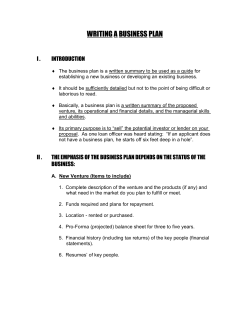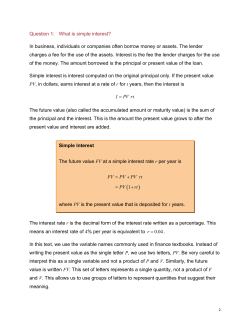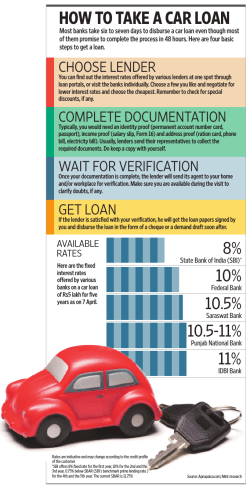
SOURCES OF FINANCE IB BUSINESS & MANAGEMENT A Course Companion (2009)
SOURCES OF FINANCE IB BUSINESS & MANAGEMENT A Course Companion (2009) P146-157 (Clark Edition) SOURCES OF FINANCE 2 • All businesses require funding for their activities. • For example – a loan to purchase a new computer system or a bank overdraft to pay suppliers before the receipt of customers cash. • Just like people, organizations require a variety of funding for a range of purposes. Factors to consider when choosing finance: 3 • A business should match the source of finance to its specific use – in practice this means that a business should secure long-term sources of finance for long term uses or needs and for more short term finance immediate needs. • The cost of the source. • The organization’s objectives. • The flexibility and availability of the finance, for example, how easy it is to switch from one form of funding to another, or whether a particular form of finance is available for a new business with no trading record. Factors to consider when choosing finance: 4 • The impact the new funding would have on the organizations current financial structure, for example, its balance sheet. • The state of the external environment, for example the economy and consumer trends. • The type of business structure it is, for example a sole trader or partnership can raise funds from the stock market. 5 INTERNAL SOURCES OF FINANCE There are several sources of internal finance for the business including: • Retained Profit • The Sales of Assets • Utilizing working capital more effectively • Depreciation INTERNAL SOURCES OF FINANCE 6 Retained Profit • This is one of the most important sources of business finance. • It represents the profits generated from sales after interest payments to lenders, taxes to the government and payments to shareholders in the form of dividends. • The remaining profit is then retained or put back into the business and available for future spending by the organization. INTERNAL SOURCES OF FINANCE 7 Retained Profit Advantages of using Retained Profit • The advantages of retained profit are that there are no associated borrowing costs and that businesses do not see a rise in debt levels (gearing). • The owners control is not diluted and decisions are not vetted by lenders (banks) INTERNAL SOURCES OF FINANCE 8 Retained Profit The Disadvantage of using Retained Profit • The disadvantages are that the owners may take out all the organization’s spare cash and there will be no buffer if the business suddenly needs cash or another market opportunity arises. • Equally some businesses are more focused on investment decisions when borrowing money, but are more lax when using retained profits. • There may no outsiders to be accountable to – especially small and family run businesses with no outside shareholders. INTERNAL SOURCES OF FINANCE 9 The Sale of Assets • Many large retail businesses that own lots of property have decided to sell off their property portfolio and raise fresh expansion capital or cash. • Supermarkets and banks are examples. They see themselves as retailers not property developers. • Companies may sell their assets to property development or pension companies and then lease then back for a fixed period of time and rent. INTERNAL SOURCES OF FINANCE 10 The Sale of Assets The Advantage of Selling Assets • The main advantage is having no associated borrowing costs or debts. Disadvantages of Selling Assets • The business can only sell off the `family silver` once, so it needs to care what is sells and how wisely it uses its cash. INTERNAL SOURCES OF FINANCE 11 The Sale of Assets Sale and Leaseback Deals • When setting up a sale and leaseback situation, it is imperative that the lease allows the business flexibility, for example, the new landlord wants to sell the site in 10 years time or up the rent above inflation. • Will there be an adequate notice period in the contract? INTERNAL SOURCES OF FINANCE 12 Utilizing Working Capital more effectively • Working capital is money tied up in the business and used to finance its day to day needs, such as buying raw materials. • All businesses have a working capital cycle that identifies how this money moves around the business Working CapitalManufacturing Case Study 13 • The first part of the cycle starts with cash being spent on raw materials. • These materials become our stock, so the cash is now tied up as unsold stock items. • When the finished items of stock are finally sold to customers, (on credit) these customers owe us money. • They in effect become the debtors of the business. • When paid, the debtors cash is returned to the business and the cycle carries on in funding new stock or paying the expenses the business (eg: paying suppliers or reducing our bank deficit. • If the business is making a profit some of this cash may be kept in the business as retained profit and not spent in the short term. 14 Reducing our Working Capital Needs • A possible source of finance is squeezing or reducing our own working capital needs. • Therefore the cash we need is more efficiently used. • Eg: IF we minimize our stock levels we reduce the amount of money tied up in stock. Just in Time Production (JIT) 15 Reducing Working Capital Needs • In modern customer manufacturing the concept of producing just in time (JIT) and only to a specific order has grown dramatically. • Eg: When a customers orders a bed or dining table they may in some cases have to be wait 2 to 4 weeks for delivery. • This is because some items are not held in stock by the retailer or manufacturer – they are both minimizing their working capital needs and the amount of money tied up in the unsold stock. • The consumer therefore pays upfront to the retailer and is effect funding the retailing and manufacturing of the product. Early Payments Incentives Reducing Working Capital Needs • A business can ask its customers who purchase goods on credit to pay more promptly, by offering a financial incentive. • Eg: A 5% discount for payment in 14 days and this helps to reduce the funding needs from the bank or shareholders. 16 Delaying Payments to Creditors Reducing Working Capital Needs • A business can slow down payment to it suppliers or creditors. • Therefore a business can use resources for longer without having paid for them. • Suppliers or creditors are being asked to fund more of our operation. 17 MRP & MRP2 Reducing Working Capital Needs • Better management of stock can be done internally and without always affecting delivery dates. • Better MRP (Material Resource Planning) and MRP2 (Manufacturing Resource Planning) systems are making the ordering of stock materials more efficient. • These systems reduce the time that stock is left unused and therefore reduce the amount of money tied up in stock. 18 The Advantages of Reducing Working Capital Needs 19 • The advantage of squeezing working capital as a source of finance is that you do not have to ask a bank or shareholders to give you more money and on terms that may be expensive. The Disadvantages of Reducing Working Capital Needs 20 • The disadvantage is that suppliers and customers may not be happy waiting for money or paying upfront for goods, especially when competitors may be able to offer a better delivery schedule for customers or better payment terms to their suppliers. • Caution has to be exercised and communication with these two stakeholders is paramount. INTERNAL SOURCES OF BUSINESS FINANCE Depreciation 21 • Depreciation is a reduction in value of our assets, which occurs naturally through wear and tear in the production process of a business. • Measuring this fall in value over time is not always easy. • There are two normal methods of calculating the level of asset depreciation: The Straight Line Method Reducing Balance Method. Straight Line Method of Depreciation 22 Example • A machine costs $500,000 to purchase. • Its useful life in our manufacturing business is 10 years. • After that we may be able to sell it to a second hand dealer for $50,000. This is called the Residual Value. Straight Line Method of Depreciation Example 23 Annual Depreciation Value = (Original Cost of Item – Residual Value) Useful Life of Asset in Years $500,000 – 50,000 10 = $45,000 depreciation each year. $50,000 – 4000 5 = 46000 5 = $9200 Straight Line Method of Depreciation 24 • The straight line method is easy to calculate and it gives us the same depreciation amount for each year. • However, the problem here is that with some assets, the drop in value is not constant, but is greater in the earlier years and less in the last years of ownership. • Assets where this is more common are cars and vans, which lose a high amount of value once they are driven offer the car outlet where they are purchased (except in Venezuela!) Reducing Balance Method of Depreciation 25 • The second method of depreciation – the reducing balance method, attempts to take account of this problem and weights the depreciation more heavily in the earlier years. How is depreciation a source of finance? (1) By recognizing that assets lose value and by attempting to identify how much each assets falls in value, it is possible to set aside cash year to replace each asset when it is no longer of use to us. (2) In many countries depreciation is a major tax deduction. Depreciation is recognized as an expense which we can claim to reduce our taxable income. 26 Other Issues with Depreciation: Inflation • A major disadvantage is that depreciation does not take into account the fall in purchasing power over time due to inflation. 27 EXTERNAL SOURCES OF FINANCE (Long Term) There are four main sources of external finance in the long term: • Share Capital • Loan Capital • Venture Capitalists • Grants from Governments & other philanthropic organizations. 28 EXTERNAL SOURCES OF FINANCE Share Capital 29 • Share capital represents the monies that are put into a company by investors, who are then classified as shareholders. • Note: Sole Traders and Partnerships don’t have shareholders and this is not a relevant source of finance for these organizations. EXTERNAL SOURCES OF FINANCE Share Capital 30 • The original investment by the owners is often used to fund the purchase of the organizations initial assets and sometimes to fund the working capital needs of the business while other funding is organized. • However, it is a long term source of finance and therefore should be used for long-term needs, such as purchasing machines or computer systems or acquiring businesses. EXTERNAL SOURCES OF FINANCE Share Capital 31 • When a business expands it can ask existing shareholders to put more money into the business and therefore new shares are issued in proportion to the size of the increase in the share capital. • Note: When people buy and selling existing shares, usually via a stock exchange, this does not help the business with raising new capital, as it is simply swapping ownership between people. Advantages of Share Capital as a Source of Finance. 32 • The advantages with this sort of finance are there are no interest payments and so no drain on company profits. • If existing shareholders increase their investment by buying more share in proportion to the current levels, there is no change in control. • However, if new shares are bought by new investors that may dilute the control of the original shareholders. Disadvantages of Share Capital as a Source of Finance. • The disadvantages are that shareholders may still expect rewards in the form of dividends, and this is paid for from profits. • However, unlike the arrangement with loan capital, if the business does not make a profit and does not have a reserve of past profits, it cannot be compelled to pay a dividend. 33 A Share Capital or Debt Capital Tradition 34 • In countries such as the UK, the amount of share capital used to fund business activities is rather low relative to debt capital. • This makes UK companies vulnerable to interest rate rises, which can hit profits directly. • In other countries, (eg: Japan & Germany) there is a tradition of investing in share capital and this makes for a more long term and perhaps more stable financial structure. EXTERNAL SOURCES OF FINANCE Debt or Loan Capital • Funding provided by outside banks and lenders is generally referred to as debt or loan capital. • It is usually provided for a fixed period of time, with repayments evenly spread out over the length of the loan. • Interest is paid on the loan at regular intervals, although interest rate holidays (where the lender agrees not to take interest for a short period of time) can be negotiated if the business is struggling to fund the debt. • Loan capital is provided for more than 1 year and so is a long term form of finance. • Any loan shorter than 1 year is classified as current liabilities or debt. 35 36 The Advantages of Loan Capital • The advantage of this form of finance is that it is often easier to access and use for specific purposes like buying fixed assets, such as machines or property. • Payment is spread out over the useful revenue-earning life of the asset. • If the loan has a fixed interest rate, and interest rates rise in the future, the loan could be a very smart investment. 37 The Disadvantages of Loan Capital • The disadvantages is that lenders have to be paid even if the business does not make a profit. • Any default (not paying the loan on time) can lead to the lender controlling future decision making, in effect they call the shots. • Equally if the loan is secured against an asset then the asset can be seized if payments are missed. • If the loan has fixed interest rate, and interest rates fall, the business may find itself with a very undesirable loan, that is a burden on the business. • However, large and very profitable organizations may be able to renegotiate terms with lenders. EXTERNAL SOURCES OF FINANCE Venture Capitalists 38 • These are specialist bankers who are more prepared to share the risks of starting a new business enterprise than traditional banks. • Venture capitalists invest in the share capital of the business and provide loan capital for the business. • Venture capitalists only target companies with great expansion or growth potential. 39 Advantages of Venture Capitalists • The advantages are that they often provide business help and contacts - perhaps for export drives or for identifying new technologies or partners. • They sit as non-executive directors to protect their investments. • They will ensure that there is a planned exit route for the investment in maybe five to seven years, often through a stock market floatation or via a trade sale. 40 Disadvantages of Venture Capitalists • The disadvantages are many for the existing shareholders as venture capitalists impose profit or sales targets. • If the businesses they invest in fail to expand as planned the venture capitalists can automatically increase their equity stakes, often from that of a minority investor to being the controlling one. • However, many organizations have used venture capital successfully and benefited from the business advice of their managers. EXTERNAL SOURCES OF FINANCE 41 Grants from governments & other philanthropic organizations • This is a growth area. • Governments, successful entrepreneurs such as Bill Gates & large corporations keen on promoting their social responsibilities, are all increasingly seeking to help the smaller business sector with grants and soft loans. • Soft loans are loans with more relaxed payment terms and lower than usual interest rates. • While the sums may be small they can make a big difference to a projects viability. • Often the problem is identifying what grants are actually available, although the internet has made the research easier. EXTERNAL SOURCES OF FINANCE (Short Term) There are several types of short term finance: • Bank Overdraft • Trade Credit • Factoring • Leasing. 42 EXTERNAL SOURCES OF FINANCE (ST) Bank Overdraft 43 • Banks finance the short-term needs of businesses by providing short term monies called overdrafts. • An overdraft is repayable on demand and should be used for short term funding needs, such as when a business is waiting for customers to pay, when it needs to pay suppliers upfront or when staff have to be paid. • When business find they are expanding very quickly due to a successful sales drive they may well find their overdraft rising as they await receipts from customers. EXTERNAL SOURCES OF FINANCE (ST) Disadvantages of a Bank Overdraft 44 • The disadvantage is that the cost of an overdraft will vary as interest rates change in the economy. • This makes budgeting costs a little difficult. • In some countries (eg UK) bank overdrafts can represent a very high proportion of total funding for a business. If the bank decides the business is struggling or that a recession is coming it may cut back the overdraft limit without much notice. • This can lead to a business failing. • Overdrafts are often secured on a personal guarantee from the owners and or the assets of the business. EXTERNAL SOURCES OF FINANCE (ST) Advantages of a Bank Overdraft 45 • The advantages are that changes in overdraft limits can be increased quite easily and it is a flexible source of finance. EXTERNAL SOURCES OF FINANCE (ST) 46 Trade Credit • Trade Credit is when a business gains extended time to pay its suppliers – perhaps 30 or 60 days after the delivery of the suppliers goods. • This means the business can in effect use its suppliers as a source of finance. EXTERNAL SOURCES OF FINANCE Factoring – Third Party Agency 47 • When working capital is tight or when a business is struggling to get paid by customers, it may consider using a third part agency to help. • A factor agent is a company that buys the current unpaid invoices of a business at a discount of, say 25%. • The factor agent pays that cash immediately to the business and hopes that it can recover more than 75% of the value of the debts in order to make it a profit. • The better the quality of the customers a business has, the greater the percentage that the factor agent may be prepared to offer upfront. EXTERNAL SOURCES OF FINANCE 48 Advantages of Factoring • The advantage is that the business receives cash upfront and can use this money to fund expansion and working capital needs more generally. • In addition, the administration cost to the business of chasing up its customers, is immediately removed. EXTERNAL SOURCES OF FINANCE 49 Disadvantages of Factoring • The disadvantage is that the business is really giving up some of its profit margin by doing this. • For example, if the firm is making a 50% profit margin already, giving away 25% of the sales value may be acceptable, but not if the business is only making a small margin. • Equally factoring will not help very small businesses and those with very marginal and local clients. • Also remember that a factor agent ringing up your biggest customer and demanding immediate payment (otherwise the customer may be taken to court) could mean that you could lose vital sales in the future. EXTERNAL SOURCES OF FINANCE 50 Leasing • When purchasing assets such as new machines or vehicles it can be sometimes be useful to consider leasing as a source of finance. • Many airlines lease purchase their aircraft. • GE, a large US finance company, is one of the largest leasing businesses in the world. • Equally leasing can be arranged with firm’s own bank. EXTERNAL SOURCES OF FINANCE 51 Advantages of Leasing • The advantages are that the business does not need to find a large initial lump sum to buy the equipment and can thus pay for the asset from its own revenue. EXTERNAL SOURCES OF FINANCE 52 Disadvantages of Leasing • The disadvantages are that the ownership of the asset does not pass to the business until the last payment has been made and the business will probably be paying a reasonably high level of interest. FINAL COMMENTS – EXTERNAL SOURCES OF FINANCE 53 • Using external financing brings in much needed funding for expansion, but it has its problems or costs. • Gearing ratios, rises as loans become a larger share of the total capital of the business, also interest cover ratios may worsen, unless profit rises proportionally as well. • Equally more long term debt will dilute the owners stake in the business and that of the lenders will rise, affecting to some extent business decision making. • It is important to consider a variety of funding sources and not to become overly dependent on one.
© Copyright 2025










